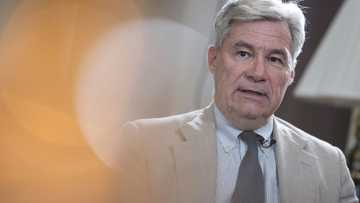
Photo: Jim WATSON / AFP
Source: AFP
Many US Federal Reserve officials were leaning against another rate cut in December, meeting minutes showed Wednesday, a move sure to infuriate President Donald Trump as he pushes for lower rates.
The minutes come amid heightened uncertainty surrounding the economic outlook, with policymakers recognizing risks to the jobs market and concerns that inflation could be more persistent than expected — even after the impact from Trump’s tariffs fade.
“Many participants suggested that, under their economic outlooks, it would likely be appropriate to keep the target range unchanged for the rest of the year,” said the minutes of the October 28-29 gathering.
At the meeting, Fed officials voted to make a second straight interest rate cut this year, bringing the benchmark lending rate to a range between 3.75-4.0 percent.
But Fed Chair Jerome Powell said shortly after unveiling the decision last month that a further reduction in December was “not a foregone conclusion.”
Any decision to keep rates steady is likely to anger Trump, who said Wednesday he would “love to fire” Powell and urged Treasury Secretary Scott Bessent to “work on” the central bank chief.
According to the minutes released Wednesday, “participants expressed strongly differing views about what policy decision would most likely be appropriate” in December.
While “most participants” found that further rate cuts would likely be appropriate over time, several indicated they did not necessarily view another 25 basis point reduction as the best choice for the upcoming meeting.
Many officials agreed that the rate-setting committee should be “deliberate in its policy decisions,” partially also because there is less availability of key economic data.
A record-long government shutdown from October to mid-November paused the release of government economic reports — including those on inflation — leaving policymakers and business in a fog as they gauge the state of the world’s biggest economy.
“These minutes underline that the FOMC (Federal Open Market Committee) remains far more divided than usual on the next steps,” said Oliver Allen of Pantheon Macroeconomics. But he expects the Fed to continue easing policy over time.
For now, many officials expect a further uptick in underlying goods inflation over the coming quarters as Trump’s tariffs bite.
But the timing and magnitude remains unclear as businesses take time to adjust prices.
When it comes to the labor market, officials generally expect conditions to “soften gradually” in the coming months, with firms reluctant to hire or lay off workers.
Many Fed officials are also noticing “a divergence in spending patterns across income groups,” the report said.
They noted that consumption growth appeared to be disproportionately supported by households with higher incomes that benefit from strong equity markets.
Lower-income households are increasingly sensitive to prices, and are adjusting their spending in response to higher costs and economic uncertainty.
In October, 10 of 12 voting members on the FOMC supported lowering rates by 25 basis points.
Of the two who disagreed, Fed Governor Stephen Miran backed a larger 50 basis point cut and Kansas City Fed President Jeffrey Schmid supported keeping rates unchanged instead.
Source: AFP
Source: Yen.com.gh












